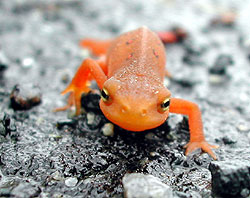Point and Shoot Macros
Builtin Macro Mode
(click for larger version)
On the Nikon and Canon P&S cameras that I have used (Nikon 775, Nikon 4500, and Canon A70), there’s a button for cycling between different focus “modes.” Look for a flower icon near one of the menu buttons, perhaps teamed up with a mountain silhouette (landscape). This button puts the camera into macro mode, which instructs the built in electronics to perform closer focusing than it normally would.
Depending on the camera you may or may not need to use the zoom control. With most lens arrangements your closest macro shots will be without any zoom. Experiment or check your manual to see what the minimum focusing distance is in macro mode. For the Nikon 775 it is three inches, the Canon A70 is five inches, no need to use zoom.
That’s pretty close, which means you might be blocking light to the subject. Changing camera position, using additional light, or positioning reflective surfaces might help.
If you don’t have enough light or the shape of the subject is odd, the camera may not be able to lock into focus or will focus on something else. One method for working around this is to pre-focus the camera.
When you push the shutter button on a digital camera, it goes through a flurry of computations and adjustments to set itself up (focus, exposure, white balance) and THEN it takes the shot. If you hold the shutter button halfway down, the camera makes all of these calculations, adjusts and locks in the focus; but it doesn’t actually take the picture. Pushing the button the rest of the way does the trick—without any further adjustments or delay.

You can use this to your advantage on hard to focus on shots. Let’s say that you are trying to photograph a newt from five inches away, but he keeps moving and going out of focus. Find a similarly lit item, hold the camera five inches away, and press the shutter halfway down. This locks in focus. Now, keeping the shutter held halfway down, point the camera at the newt and press the shutter button the rest of the way when you have the framing that you want. The camera doesn’t have to “think” at all and instantly takes the photo.
You do have to be careful about the lighting and color of the object you use to lock focus. The camera is using those parameters to pre-calculate the exposure and white balance settings. It can be fun to experiment; changing the tone of the final shot by pre-focusing on a denim leg (cool) or your palm (warm).
Some cameras let you preset the white balance, but that topic is a little outside the realm of this article. Check your manual. The side bar also has links to related articles.
| «Introduction | Page 2 of 8 | Getting Even Closer» |
